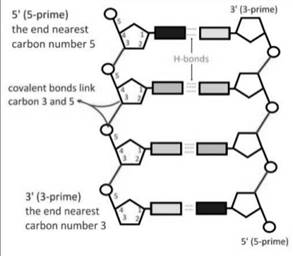
Concept explainers
Interpretation:
The complementary base pairing between the two individual strands of DNA needs to be explained.
Concept introduction:
DNA- deoxyribonucleic acid, it is a genetic material for a cell. Mainly it is found in the nucleus of the cell.Itis consists of a deoxyribose sugar, a phosphate, and nitrogenous bases.The nitrogenous bases of two strands are linked with hydrogen bond and the covalent type of bonding occurs within the chain of each strand of the double helix.
Answer to Problem 35A
There are two types of bonding present in the DNA, one is covalent and the other one is hydrogen bonding.The hydrogen bonding involved in the replication of the DNA molecules during the cell division.
Explanation of Solution
The double helix structure of DNA is a complex and twisted ladder-like structure where the deoxy sugar, nitrogenous base, and phosphate group are present.The nitrogenous base is linked with complementary pairing, where two hydrogen bonds present between the adenine and thymine, and three hydrogen bonds present between cytosine and guanine.
There pairing is always fixed with an individual strand or other strands during the replication process.


With the help of complementary base pairing the replication of DNA is easier. In DNA, always three hydrogen bonds present between cytosine and guanine, two bonds between thymine and adenine.
Chapter 21 Solutions
World of Chemistry, 3rd edition
 ChemistryChemistryISBN:9781305957404Author:Steven S. Zumdahl, Susan A. Zumdahl, Donald J. DeCostePublisher:Cengage Learning
ChemistryChemistryISBN:9781305957404Author:Steven S. Zumdahl, Susan A. Zumdahl, Donald J. DeCostePublisher:Cengage Learning ChemistryChemistryISBN:9781259911156Author:Raymond Chang Dr., Jason Overby ProfessorPublisher:McGraw-Hill Education
ChemistryChemistryISBN:9781259911156Author:Raymond Chang Dr., Jason Overby ProfessorPublisher:McGraw-Hill Education Principles of Instrumental AnalysisChemistryISBN:9781305577213Author:Douglas A. Skoog, F. James Holler, Stanley R. CrouchPublisher:Cengage Learning
Principles of Instrumental AnalysisChemistryISBN:9781305577213Author:Douglas A. Skoog, F. James Holler, Stanley R. CrouchPublisher:Cengage Learning Organic ChemistryChemistryISBN:9780078021558Author:Janice Gorzynski Smith Dr.Publisher:McGraw-Hill Education
Organic ChemistryChemistryISBN:9780078021558Author:Janice Gorzynski Smith Dr.Publisher:McGraw-Hill Education Chemistry: Principles and ReactionsChemistryISBN:9781305079373Author:William L. Masterton, Cecile N. HurleyPublisher:Cengage Learning
Chemistry: Principles and ReactionsChemistryISBN:9781305079373Author:William L. Masterton, Cecile N. HurleyPublisher:Cengage Learning Elementary Principles of Chemical Processes, Bind...ChemistryISBN:9781118431221Author:Richard M. Felder, Ronald W. Rousseau, Lisa G. BullardPublisher:WILEY
Elementary Principles of Chemical Processes, Bind...ChemistryISBN:9781118431221Author:Richard M. Felder, Ronald W. Rousseau, Lisa G. BullardPublisher:WILEY





